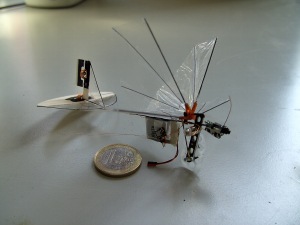Jul 22 2008
On Wednesday 23 July, TU Delft will be presenting the minute DelFly Micro air vehicle. This successor to the DelFly I and II weighs barely 3 grams, and with its flapping wings is very similar to a dragonfly. Ultra-small, remote-controlled micro aircraft with cameras, such as this DelFly, may well be used in the future for observation flights in difficult-to-reach or dangerous areas. The DelFly Micro will make a short demonstration flight during the presentation.
 The DelFly Micro is a 'Micro Air Vehicle' (MAV), an exceptionally small remote-controlled aircraft with camera and image recognition software. The Micro, weighing just 3 grams and measuring 10 cm (wingtip to wingtip) is the considerably smaller successor to the successful DelFly I (2005) and DelFly II (2006).
The DelFly Micro is a 'Micro Air Vehicle' (MAV), an exceptionally small remote-controlled aircraft with camera and image recognition software. The Micro, weighing just 3 grams and measuring 10 cm (wingtip to wingtip) is the considerably smaller successor to the successful DelFly I (2005) and DelFly II (2006).
The DelFly Micro is a 'Micro Air Vehicle' (MAV), an exceptionally small remote-controlled aircraft with camera and image recognition software. The Micro, weighing just 3 grams and measuring 10 cm (wingtip to wingtip) is the considerably smaller successor to the successful DelFly I (2005) and DelFly II (2006). The DelFly Micro, with its minuscule battery weighing just 1 gram, can fly for approximately three minutes and has a maximum speed of 5 m/s.
Ultra-small remote-controlled, camera-equipped aircraft are potentially of great interest because they could eventually be used for observation flights in difficult-to-reach or dangerous areas.
Nature
The basic principle of the DelFly is derived from nature. The 'dragonfly' has a tiny camera (about 0.5 grams) on board that transmits its signals to a ground station. With software developed by TU Delft itself, objects can then be recognised independently. The camera transmits TV quality images, and therefore allows the DelFly II to be operated from the computer. It can be manoeuvred using a joystick as if the operator was actually in the cockpit of the aircraft. The aim is to be able to do this with the DelFly Micro too.
Miniaturisation
The development of the DelFly is above all the story of continuing miniaturisation of all the parts, from the DelFly I (23 grams and 50 cm) via the DelFly II (16 grams and 30 cm) to the present DelFly Micro (3 grams and 10 cm). The DelFly II drew huge attention in 2006 because it could fly horizontally (21 km/hr) as well as hover, just like a hummingbird, and also fly backwards. The DelFly Micro, incidentally, cannot do this just yet. In a few years time, the new objective of the project, the DelFly NaNo (5 cm, 1 gram) will have been developed. The Micro is an important intermediate step in this development process. A second objective for the future is for the DelFly to be able to fly entirely independently thanks to image recognition software.
Presentation
The press presentation of the DelFly Micro will be on Wednesday 23 July, from 1 pm to 2 pm in Hall A of the Sports and Cultural Centre, Mekelweg 8-10, 2628 CD Delft. During the presentation, the DelFly Micro will make a short demonstration flight (indoors). In addition, a recent film of a flight will also be made available. This is due to the fact that it is difficult to film in this location because of the speed of the DelFly in combination with its manoeuvrability.
More information
For more information and to register for the presentation, please contact Charlotte de Kort, Marketing & Communication, Faculty of Aerospace Engineering, [email protected] , +31 6 14015135.
See www.delfly.nl for more information on all DelFly's